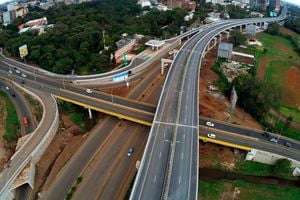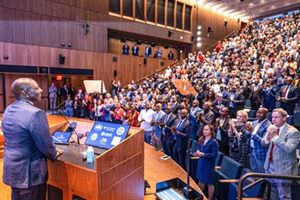
An aerial view of the Nairobi Expressway along Waiyaki Way on November 12, 2021.
Passenger fares and the cost of transporting goods on the Mombasa-Nairobi highway are likely to increase following a decision by the government to force trucks and buses on the proposed high-speed highway to be built by a consortium of US companies.
In an investor presentation, the consortium for the Mombasa-Nairobi Expressway, disclosed that this is one of the six responsibilities of the government in the Sh477.9 billion public private partnership (PPP).
The government has also agreed to adjust the toll fees charged by the consortium in case of exchange rate fluctuations, a move that will see the user fees paid by the motorists rise when the shilling weakens.
Although the contractors of the toll, dubbed Usahihi Expressway, have insisted that some of the financing will come from local investors, a big chunk of the debt financing is expected to come from US and UK investors.
The 440-kilometre four-lane dual carriageway will be built by a consortium of US firms led by private equity (PE) Everstrong Capital LL.
Last week, Everstrong signed a development agreement with the Kenya National Highways Authority (KeNHA) for the construction of the road that the US expects to rival the Chinese-built Standard Gauge Railway (SGR) which traverses the same route.
“The Government of Kenya has some important responsibilities: decommission the existing road for all trucks and buses,” reads part of the presentation.
The government of retired President Uhuru Kenyatta had a similar arrangement with the Chinese financiers of the Standard Gauge Railway (SGR) in which importers moving goods to Nairobi from the Port of Mombasa to Nairobi were forced to use the SGR.
President William Ruto reversed the directive when he came to power in keeping with his campaign promise to the Coastal people that he would ‘bring the port back to Mombasa.’
The coastal town is a popular destination for business and leisure, with travellers having the option of either using the SGR or the existing Mombasa highway.
While the existing highway will be retained, buses and trucks will not have the choice of using the free road— a move that will push up freight charges and bus fares.
Passengers travelling by bus ordinarily pay between Sh1,300 and Sh1,500.
Kenya Railways raised the fare prices for the SGR train between Nairobi and Mombasa by 50 percent in January in a bid to keep up with the rising costs of running the train service, especially the higher fuel prices. Passengers in first class coaches now pay Sh4,500 from Sh3,000 to travel between Nairobi and Mombasa. Those travelling in economy class coaches are paying Sh1,500 , upfrom Sh1,000.
Forcing buses and trucks on the Expressway means transporters will raise their costs to cover for the toll fees that they will be charged.
Everstrong, which is the lead sponsor of the project, has not revealed the toll fees it will charge motorists in the 30 years it will operate the concession.
The government will also be allowed to revise the toll rate to hedge against exchange rate risks. This means toll fees will go up should the shilling be devalued, as it happened recently with the Nairobi Expressway.
Construction of the road is set to begin in 2026, the presentation shows. The entire project is set to end in 2029.
While Kenya has moved to adopt Public Private Partnership (PPP), including investors building and charging toll fees, getting adequate traffic has been a challenge for most of the proposed toll roads.
Disagreements over the proposed toll fees for the Nairobi-Nakuru-Mai Mahiu toll road forced the government to pull the plug on the 233-kilometre highway.
Project was terminated
KeNHA said the project was terminated because the contractor of the Mau Summit toll road, which included a consortium of French contractors, did not want to change the terms of the contract.
Through the Availability Based Service Payment Model, if the contractor does not get the specified traffic, the government would compensate for the deficit to guarantee investors returns, said Kenha in a statement.
KeNHA said that although the project was a PPP, the government was allocated the traffic risk due to lack of historical data on the performance or acceptability of toll roads in Kenya. There was also no reliable traffic data that could be used for toll revenue projections.
Construction of Usahihi Expressway is one of the deals signed by President Ruto during his State visit to the US.
The project will be partly financed by local investors, including commercial banks. The project will have a debt to equity split of 70 percent and 30 percent, respectively.
Initially, Bechtel was to start the construction of the road in 2018 but did not agree with the government on the financing model. Bechtel wanted the government to pay for it through debt, but the government insisted it wanted it to be a PPP.
Bechtel would later return to the negotiating table with a different financing model having teamed up with Everstrong.
With Kenya running out of headroom for borrowing, it has resorted to PPP to build most of its major infrastructure projects including roads and dams.
However, the cost of these projects, especially where they are funded using foreign denominated loans, has tended to go up whenever the exchange rate has fluctuated hurting consumers.









